Submitted:
10 May 2023
Posted:
10 May 2023
You are already at the latest version
Abstract
Keywords:
1. Introduction
2. Materials and Methods
2.1. Materials and sample preparation
2.2. Textural characteristics: texture profile analysis
2.3. Dynamic rheological properties
2.4. Starch digestion in vitro and its kinetics
2.5. Microstructural characteristics
2.5.1. Light microscopy (LM)
2.5.2. Scanning electron microscopy (SEM)
2.5.3. Confocal laser scanning microscopy (CLSM)
2.6. Particle size distribution
2.7. Thermal analysis
2.8. Statistical analysis
3. Results and discussion
3.1. Texture profile analysis-textural characteristics
3.2. Rheological properties
3.3. Starch hydrolysis (%) and estimated glycaemic index
3.4. Microstructural
3.5. Particle size distribution and thermal properties of Yangyu jiaotuan digesta
4. Conclusions
Acknowledgments
References
- Do, D. T., Singh, J., Oey, I., & Singh, H. Biomimetic Plant Foods: Structural design and functionality. Trends in Food Science & Technology 2018, 82, 46-59.
- Alfieri, M. L., Moccia, F., D’Errico, G., Panzella, L., d’Ischia, M., & Napolitano, A. Acid Treatment Enhances the Antioxidant Activity of Enzymatically Synthesized Phenolic Polymers. Polymers, 2020, 12, 2544.
- Dinu, V., Yakubov, G. E., Lim, M., Hurst, K., & Fisk, I. D. Mucin immobilization in calcium alginate: A possible mucus mimetic tool for evaluating mucoadhesion and retention of flavour. International Journal of Biological Macromolecules, 2019, 138, 831-836.
- Colussi, R., Kaur, L., Zavareze, E. d. R., Dias, A. R. G., Stewart, R. B., & Singh, J. High pressure processing and retrogradation of potato starch: Influence on functional properties and gastro-small intestinal digestion in vitro. Food Hydrocolloids, 2018, 75, 131-137.
- Schwanz Goebel, J. T., Kaur, L., Colussi, R., Elias, M. C., & Singh, J. Microstructure of indica and japonica rice influences their starch digestibility: A study using a human digestion simulator. Food Hydrocolloids 2019, 94, 191-198.
- Wahlqvist, M. L. Food structure is critical for optimal health. Food & function, 2016, 10.1039.C1035FO01285F.
- Aguilera, J. M., & Stanley, D. W. Microstructural principles of food processing and engineering (2nd ed.), 1999, Maryland: Aspen Publishers Inc.
- Bornhorst, G. M., & Paul Singh, R. Gastric digestion in vivo and in vitro: how the structural aspects of food influence the digestion process. Annual Review of Food Science & Technology, 2014, 5, 111.
- Edwards, C. H., Warren, F. J., Campbell, G. M., Gaisford, S., Royall, P. G., Butterworth, P. J., & Ellis, P. R. A study of starch gelatinisation behaviour in hydrothermally-processed plant food tissues and implications for in vitro digestibility. Food & function, 2015, 6, 3634-3641.
- Glatter, O., & Salentinig, S. Inverting Structures: From Micelles via Emulsions to Internally Self-assembled Water- and Oil-Continuous Nanocarriers. Current Opinion in Colloid & Interface Science, 2020, 49, 82-93.
- Do, D. T., Singh, J., Oey, I., Singh, H., Yada, R. Y., & Frostad, J. M. A novel apparatus for time-lapse optical microscopy of gelatinisation and digestion of starch inside plant cells. Food Hydrocolloids, 2020, 104, 105551.
- Alvarez, M. D., Fernandez, C., Olivares, M. D., & Canet, W. A rheological characterisation of mashed potatoes enriched with soy protein isolate. Food Chemistry, 2012, 133, 1274-1282.
- Korus, J., Witczak, M., Ziobro, R., & Juszczak, L. The impact of resistant starch on characteristics of gluten-free dough and bread. Food Hydrocolloids, 2009, 23, 988-995.
- Chen, Y. F., Singh, J., Midgley, J., & Archer, R. (). Influence of time-temperature cycles on potato starch retrogradation in tuber and starch digestion in vitro. Food Hydrocolloids, 2020, 98, 105210-105240.
- Tamura, M., Singh, J., Kaur, L., & Ogawa, Y. Impact of the degree of cooking on starch digestibility of rice – An in vitro study. Food Chemistry, 2016, 98-104.
- Goñi, I., Garcia-Alonso, A., & Saura-Calixto, F. A starch hydrolysis procedure to estimate glycemic index. Nutrition Research, 1997, 17, 427-437.
- Singh, J., Mccarthy, O. J., Singh, H., & Moughan, P. J. Low temperature post-harvest storage of New Zealand Taewa (Maori potato): Effects on starch physico-chemical and functional characteristics. Food Chemistry, 2008, 106, 583-596.
- Colussi, R., Singh, J., Kaur, L., Zavareze, E. D. R., Guerra Dias, A. R., Stewart, R. B., & Singh, H. Microstructural characteristics and gastro-small intestinal digestion in vitro of potato starch: Effects of refrigerated storage and reheating in microwave. Food Chemistry, 2017, 226, 171-178.
- Singh, J., Dartois, A., & Kaur, L. Starch digestibility in food matrix: a review. Trends in Food ence & Technology, 2010, 21, 168-180.
- Lakemond, C. M. M., Jongh, H. H. J. d., Paques, M., Vliet, T. v., Gruppen, H., & Voragen, A. G. J. Gelation of soy glycinin; influence of pH and ionic strength on network structure in relation to protein conformation. Food Hydrocolloids, 2003, 17, 365-377.
- Tseng, Y.-C., Xiong, Y. L., & Yang, F. Influence of inulin/oligofructose on the acid-induced cold aggregation and gelation of preheated soy proteins. Journal of the Science of Food & Agriculture, 2009, 89, 2650-2658.
- Jarvis, M. C., Mackenzie, E., & Duncan, H. J. The textural analysis of cooked potato swelling pressure of starch during gelatinisation. Potato research, 1992, 35, 93-102.
- Berg, T., Singh, J., Hardacre, A., & Boland, M. J. The role of cotyledon cell structure during in vitro digestion of starch in navy beans. Carbohydrate polymers, 2012, 87, 1678-1688.
- Tydeman, E. A., Parker, M. L., Wickham, M. S. J., Rich, G. T., Faulks, R. M., Gidley, M. J., Fillery-Travis, A., & Waldron, K. W. Effect of carrot (Daucus carota) microstructure on carotene bioaccessibilty in the upper gastrointestinal tract in vitro simulations of carrot digestion. J Agric Food Chem, 2010, 58, 9847-9854.
- Chen, Y. F., Singh, J., & Archer, R. Potato starch retrogradation in tuber : Structural changes and gastro-small intestinal digestion in vitro. Food Hydrocolloids, 2018, 84, 552-560.
- Hoebler, Devaux, M. F., Karinthi, A., & C. Particle size of solid food after human mastication and in vitro simulation of oral breakdown. International Journal of Food ences & Nutrition, 2000, 51, 353-366.
- Fang, C., Huang, J., Yang, Q., Pu, H., & Zhu, Z. Adsorption capacity and cold-water solubility of honeycomb-like potato starch granule. International Journal of Biological Macromolecules, 2020, 147, 741-749.
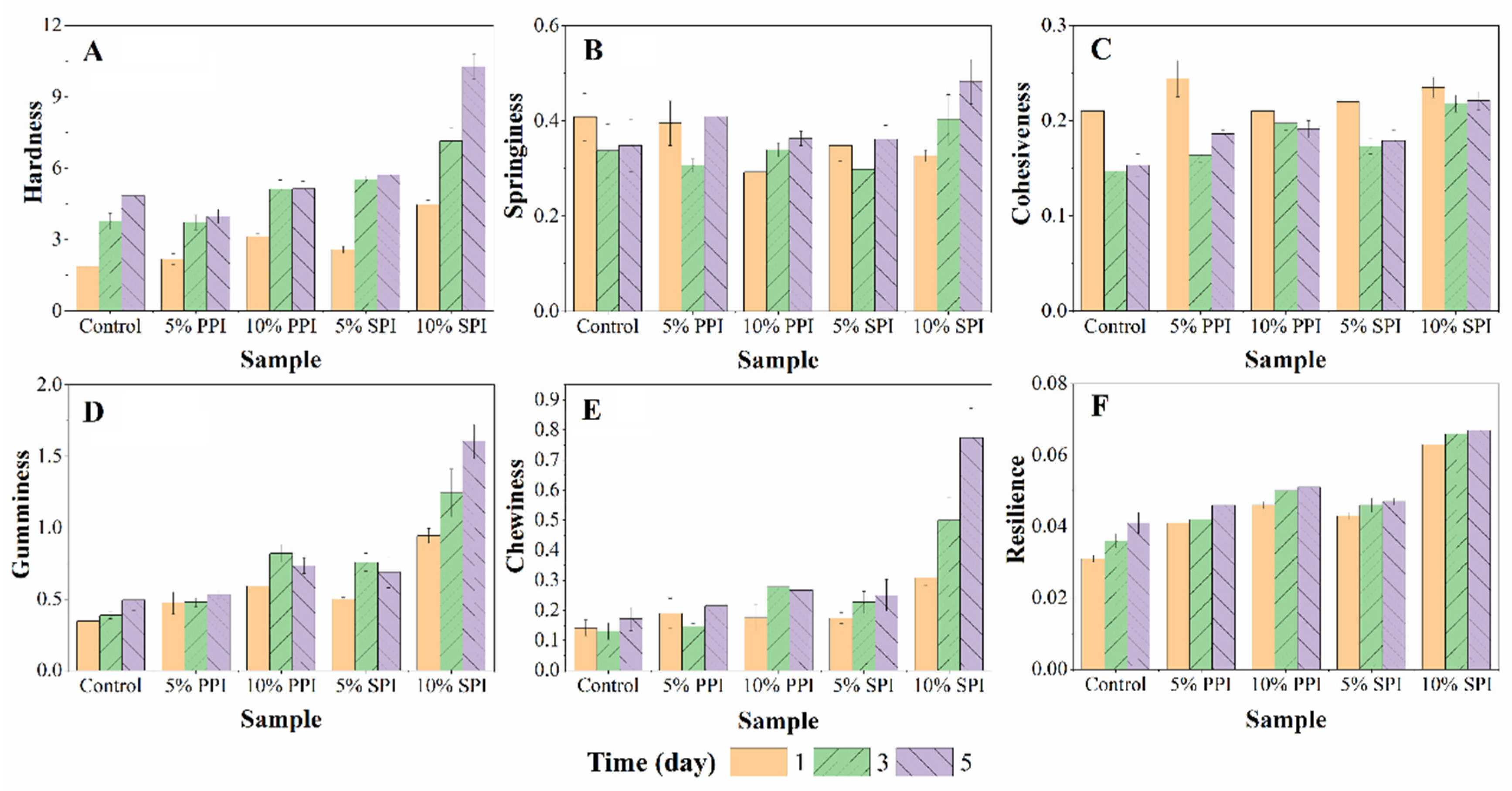
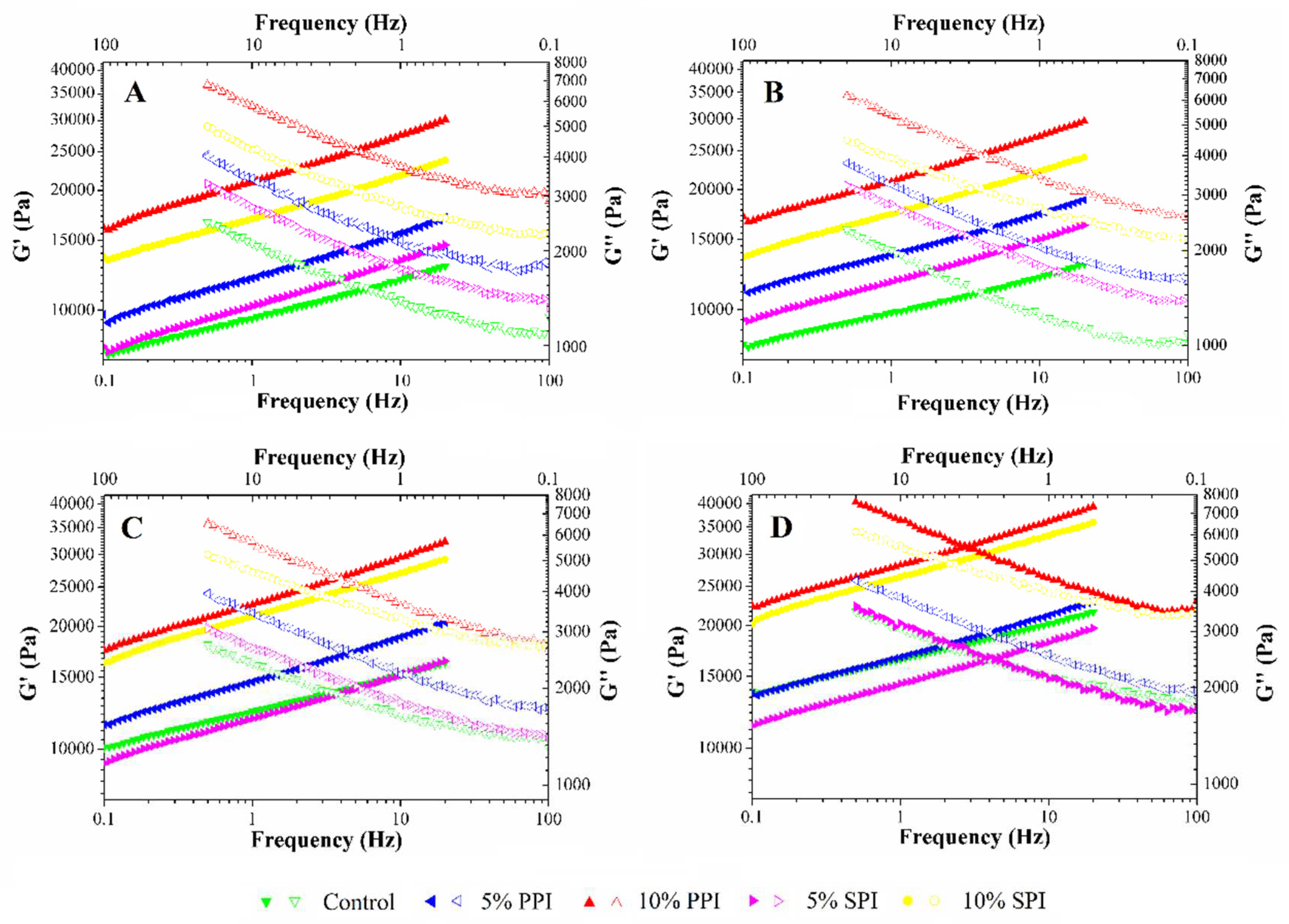
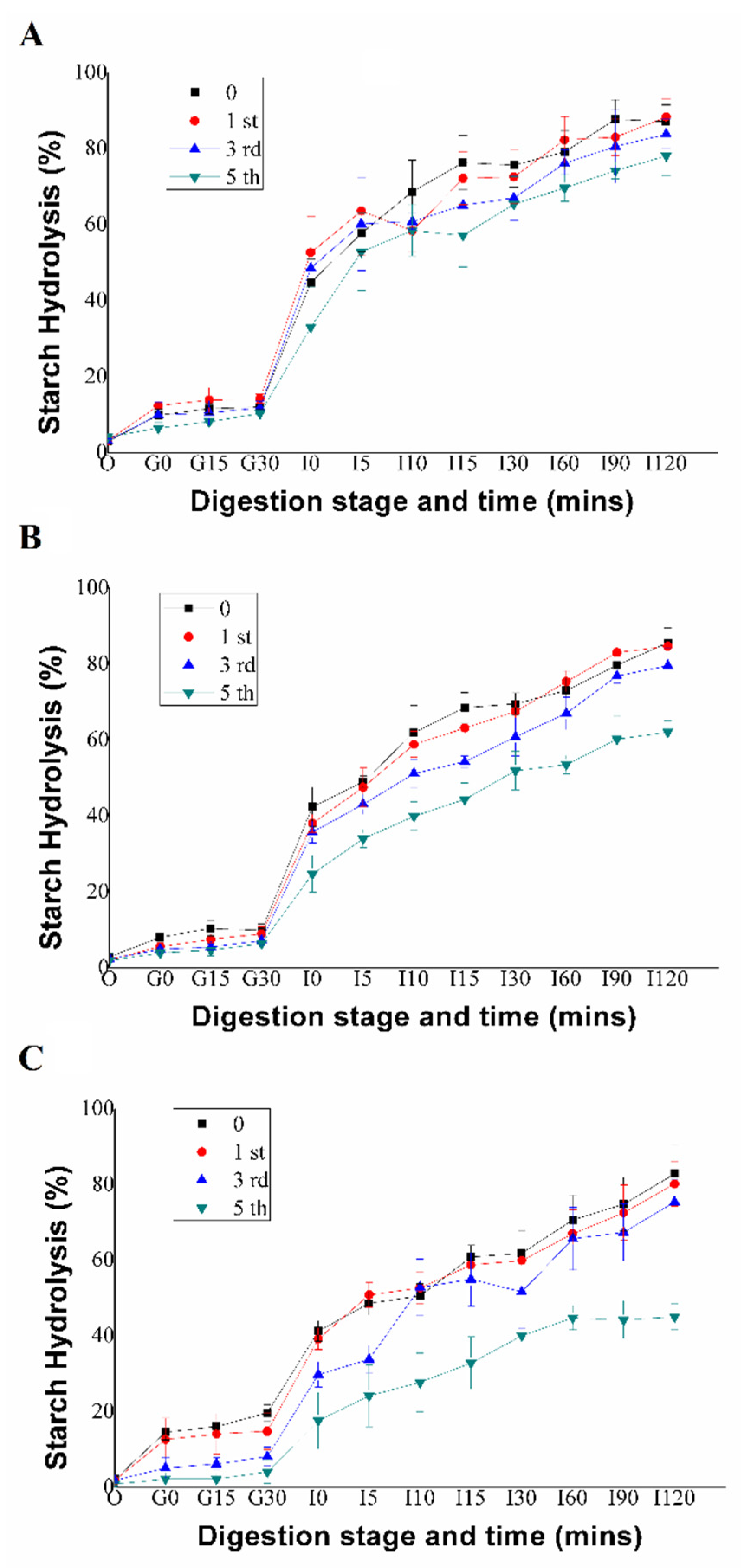

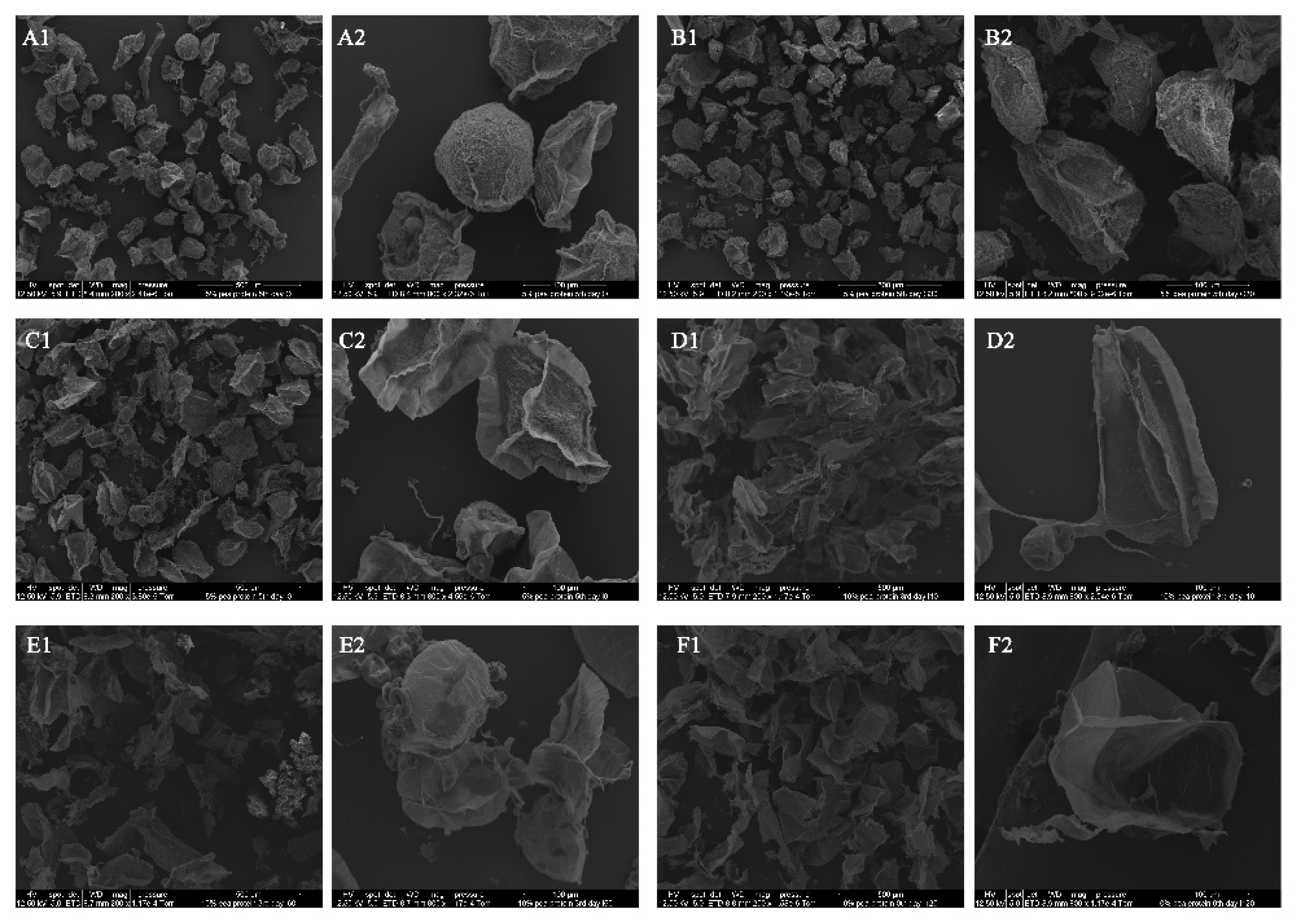
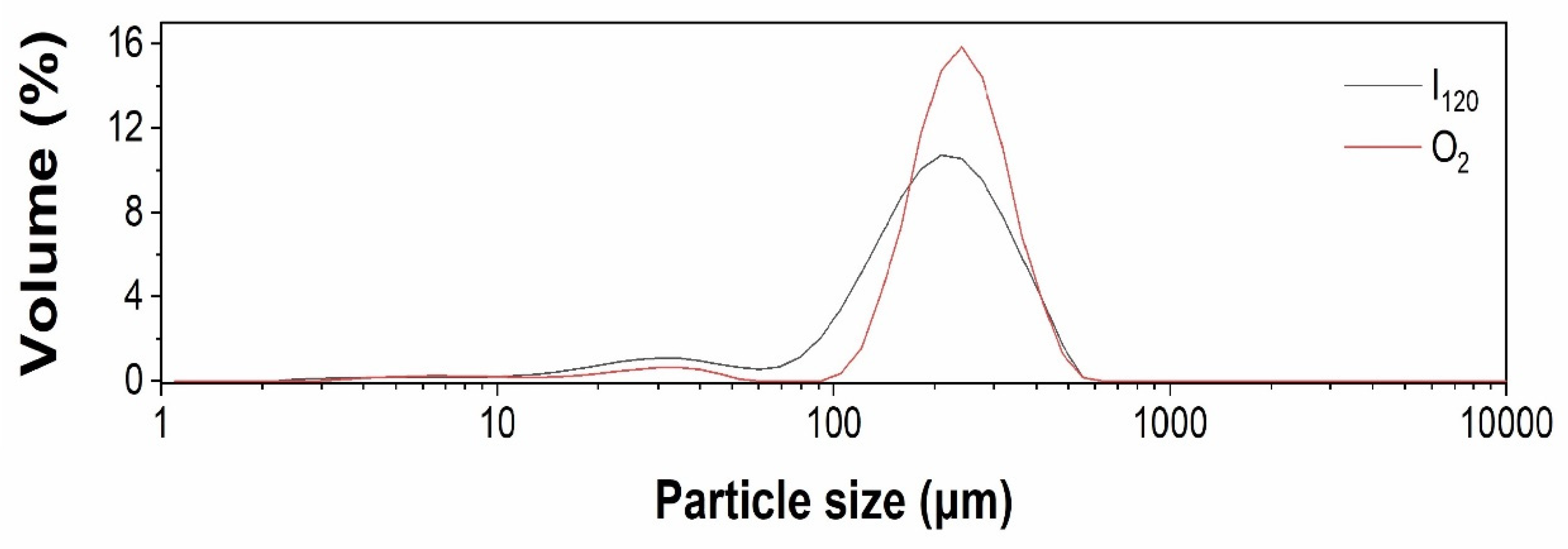

| Sample | Time (day) | Rheological properties during frequency sweepa | |||||
|---|---|---|---|---|---|---|---|
| G’(Pa) | G’’(Pa) | G* (Pa) | tan δ | η* (Pa s) | ή (Pa s) | ||
| Control | 0 | 12406.67±601.86a | 2451.33±98.35a | 12646.67±608.80a | 0.20±0.00hi | 100.650±4.84a | 19.50±0.78a |
| 1 | 12670.00±357.63a | 2263.33±64.47a | 12870.00±361.66a | 0.18±0.00d | 102.423±2.88a | 18.04±0.48a | |
| 3 | 17130.00±742.23cd | 2809.67±75.58b | 17353.33±744.47c | 0.16±0.008b | 138.100±5.93c | 22.36±0.60b | |
| 5 | 21993.33±349.33f | 3518.33±57.93de | 22273.33±349.33e | 0.16±0.00a | 177.233±2.80e | 28.00±0.47de | |
| 5% PPI | 0 | 15983.33±1485.98c | 3800.33±305.35e | 16426.67±1514.48c | 0.24±0.00m | 130.733±12.04c | 30.24±2.43e |
| 1 | 18786.67±85.05de | 3782.67±4.73e | 19160.00±80.00d | 0.20±0.00i | 152.467±.65d | 30.10±0.04e | |
| 3 | 19720.00±713.58e | 3797.00±139.93e | 20056.67±685.30d | 0.19±0.00g | 159.833±5.75d | 30.22±1.12e | |
| 5 | 23183.33±242.14fg | 4339.33±65.455f | 23583.33±250.07ef | 0.19±0.00ef | 187.667±1.95ef | 34.53±0.52f | |
| 10% PPI | 0 | 29863.33±814.51hi | 6837.67±172.93j | 30636.67±829.84gh | 0.23±0.00l | 243.800±6.56gh | 54.42±1.38j |
| 1 | 28710.00±814.13h | 5971.00±152.97h | 29326.67±825.67g | 0.21±0.00j | 233.367±6.61g | 47.52±1.22h | |
| 3 | 31116.67±1001.67i | 6269.67±190.08i | 31740.00±1024.31h | 0.20±0.00i | 252.567±8.15h | 49.90±1.51i | |
| 5 | 38660.00±606.05j | 7502.67±104.01k | 39383.33±611.58i | 0.19±0.00gh | 313.400±4.8816i | 59.70±0.83k | |
| 5% SPI | 0 | 14190.00±1212.97b | 3191.67±245.90c | 14543.33±1241.02b | 0.23±0.00k | 115.767±9.86b | 25.40±1.96c |
| 1 | 15786.67±440.72c | 3148.67±59.69c | 16100.00±446.43c | 0.20±0.00i | 128.100±3.59c | 25.06±0.48c | |
| 3 | 16466.67±775.13c | 3106.33±125.60c | 16756.67±785.13c | 0.19±0.00f | 133.367±6.25c | 24.72±1.00c | |
| 5 | 18473.33±1115.05de | 3387.67±148.08cd | 18783.33±1124.47d | 0.18±0.00e | 149.467±8.92d | 26.96±1.18cd | |
| 10% SPI | 0 | 24560.00±919.95g | 5169.67±202.44g | 25103.33±944.79f | 0.21±0.00j | 199.733±7.4782f | 41.14±1.61g |
| 1 | 24710.00±547.81g | 4554.67±69.21f | 25126.67±553.38f | 0.18±0.00ef | 199.967±4.36f | 36.24±0.55f | |
| 3 | 29616.67±368.56hi | 5263.00±48.54g | 30080.00±370.41gh | 0.18±0.00d | 239.367±2.97gh | 41.88±0.39g | |
| 5 | 37663.33±1652.58j | 6416.67±276.31i | 38210.00±1677.71i | 0.17±0.00c | 304.033±13.32i | 51.06±2.20i | |
| Sample | Time (day) | G′ change (%) | G′′ change (%) | η* change (%) |
|---|---|---|---|---|
| Control | 1 | 2.12 | -7.67 | 1.76 |
| 3 | 38.07 | 14.62 | 37.21 | |
| 5 | 77.27 | 43.53 | 76.09 | |
| 5% PPI | 1 | 17.54 | -0.46 | 16.62 |
| 3 | 23.38 | -0.09 | 22.26 | |
| 5 | 45.05 | 14.18 | 43.55 | |
| 10% PPI | 1 | -3.86 | -12.67 | -4.28 |
| 3 | 4.20 | -8.31 | 3.60 | |
| 5 | 29.46 | 9.73 | 28.55 | |
| 5% SPI | 1 | 11.25 | -1.35 | 10.65 |
| 3 | 16.04 | -2.67 | 15.20 | |
| 5 | 30.19 | 6.14 | 29.11 | |
| 10% SPI | 1 | 0.61 | -11.90 | 0.12 |
| 3 | 20.59 | 1.81 | 19.84 | |
| 5 | 53.35 | 24.12 | 52.22 |
| Hardness | Springiness | Cohesiveness | Gumminess | Chewiness | Resilience | G′ | G′′ | G* | tan δ | η* | ή | |
|---|---|---|---|---|---|---|---|---|---|---|---|---|
| Hardness | 1.000 | |||||||||||
| Springiness | 0.203 | 1.000 | ||||||||||
| Cohesiveness | 0.026 | 0.318* | 1.000 | |||||||||
| Gumminess | 0.888** | 0.217 | 0.429** | 1.000 | ||||||||
| Chewiness | 0.876** | 0.447** | 0.448** | 0.964** | 1.000 | |||||||
| Resilience | 0.795** | 0.146 | 0.431** | 0.938** | 0.871** | 1.000 | ||||||
| G′ | 0.658** | 0.144 | 0.206 | 0.680** | 0.659** | 0.692** | 1.000 | |||||
| G′′ | 0.518** | 0.070 | 0.249 | 0.578** | 0.539** | 0.619** | 0.973** | 1.000 | ||||
| G* | 0.654** | 0.141 | 0.208 | 0.677** | 0.655** | 0.690** | 1.000** | 0.975** | 1.000 | |||
| tan δ | -0.393** | -0.214 | 0.368* | -0.186 | -0.252 | -0.069 | 0.078 | 0.296* | 0.085 | 1.000 | ||
| η* | 0.654** | 0.141 | 0.208 | 0.677** | 0.655** | 0.690** | 1.000** | 0.975** | 1.000** | 0.085 | 1.000 | |
| ή | 0.517** | 0.070 | 0.249 | 0.578** | 0.539** | 0.619** | 0.973** | 1.000** | 0.975** | 0.296 | 0.975** | 1.000 |
| Sample | Time (day) | C∞ experimental (%) | C∞ estimated (%) | AUC | HI | eGI |
|---|---|---|---|---|---|---|
| Control | 0 | 87.13±4.39c | 88.31±3.83de | 9728.93±164.21e | 129.84±2.19e | 110.99±1.20e |
| 1st | 88.33±4.79c | 87.06±1.30de | 9618.57±288.71e | 128.37±3.85e | 110.18±2.12e | |
| 3rd | 83.83±3.89c | 83.14±6.40cde | 9137.26±411.84de | 121.95±5.50de | 106.66±3.02de | |
| 5th | 78.11±5.13c | 75.46±5.11cd | 8418.05±682.57cde | 112.35±9.11cde | 101.39±5.00cde | |
| 5% PPI | 0 | 85.59±3.97c | 82.35±3.68cde | 9070.40±394.32de | 121.05±5.26de | 106.17±2.89de |
| 1st | 84.66±2.45c | 81.07±2.06cde | 8922.15±222.79de | 119.08±2.97de | 105.08±1.63de | |
| 3rd | 83.33±0.74c | 79.61±3.19cde | 8679.75±741.24cde | 115.84±9.89cde | 103.31±5.43cde | |
| 5th | 62.09±2.97b | 59.14±3.44b | 6478.45±512.51b | 86.46±6.84b | 87.18±3.76b | |
| 10% PPI | 0 | 82.86±7.47c | 79.01±5.82cde | 8534.99±598.30cde | 113.91±7.98cde | 102.25±4.38cde |
| 1st | 80.18±5.92c | 76.60±4.70cde | 8257.78±602.94cd | 110.21±8.05cd | 100.21±4.42cd | |
| 3rd | 75.41±5.90c | 70.70±4.91c | 7501.22±507.75c | 100.11±3.72c | 94.67±3.72c | |
| 5th | 45.06±3.43a | 43.06±3.28a | 4822.26±405.86a | 64.36±5.41a | 75.04±2.97a |
Disclaimer/Publisher’s Note: The statements, opinions and data contained in all publications are solely those of the individual author(s) and contributor(s) and not of MDPI and/or the editor(s). MDPI and/or the editor(s) disclaim responsibility for any injury to people or property resulting from any ideas, methods, instructions or products referred to in the content. |
© 2023 by the authors. Licensee MDPI, Basel, Switzerland. This article is an open access article distributed under the terms and conditions of the Creative Commons Attribution (CC BY) license (http://creativecommons.org/licenses/by/4.0/).





